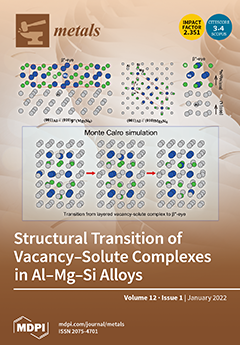The carbon steel B450C and low chromium SS 430 ferritic samples were exposed for 30 days to chloride-containing (5 g L
−1 NaCL) cement extract solution. The initial pH ≈ 13.88 decreased to pH ≈ 9.6, associated mainly with the consumption of OH
[...] Read more.
The carbon steel B450C and low chromium SS 430 ferritic samples were exposed for 30 days to chloride-containing (5 g L
−1 NaCL) cement extract solution. The initial pH ≈ 13.88 decreased to pH ≈ 9.6, associated mainly with the consumption of OH
− ions and the formation of γ-FeOOH, α-FeOOH, Fe
3O
4 and Cr(OH)
3, as suggested by XRD and XPS analysis, in the presence of CaCO
3 and NaCl crystals. The deep corrosion damages on B450C were observed around particles of Cu and S as local cathodes, while the first pitting events on the SS 430 surface appeared after 30 days of exposure. The change in the activity of each type of steel was provided by the potentiodynamic polarization curves (PDP). Two equivalent electrical circuits (EC) were proposed for quantitative analysis of EIS (Nyquist and Bode diagrams). The calculated polarization resistance (R
p), as an indicator of the stability of passive films, revealed that SS 430 presented relatively constant values, being two-three orders of magnitude higher than those of the carbon steel B450C. The calculated thickness (
d) of the SS 430 passive layers was ≈0.5 nm and, in contrast, that of the B450C passive layers tends to disappear after 30 days.
Full article





